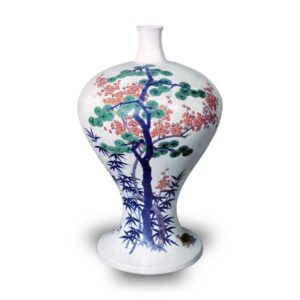
Also called Iro-e Nabeshima. It is the main focus of Nabeshima ware and is the so-called “color painting of Nabeshima ware” of the Okawachi kiln in Nishimatsuura County (Okawachi Town, Imari City), which was the official kiln of the Marquis Nabeshima of the Saga Domain in the Hizen Province. Along with the quaint but bold works of Ko-Kutani and the gorgeous and elegant works of Kakiemon, Nabeshima porcelain is considered to be one of the finest examples of porcelain of the Edo period. The reason why it was especially prized is because it was forbidden to be used for private purposes and was not released to the public as an official product of the Marquis of Nabeshima until the Meiji Restoration, but also because it was extremely elaborately made using particularly sophisticated techniques.
The most common type of Nabeshima dish is one that has a certain form, and the base material is extremely precise in shape, with no deviations of any kind and almost no spots. The painting is extremely precise and labor-intensive, and shows a quality that is only possible with products made by the imperial kiln. The design is also excellent, the colors are well harmonized, and the dish shows a calm, weighty, and elegant mood without regret, boasting a beauty that others cannot match, along with the beauty of the expertly executed lines. The shape and curvature of the plate are unique, and the design is purely Japanese, free from Chinese and Korean influences, and only Insei is comparable to it. The curved surface of the plate and the pattern are in perfect harmony, creating a graceful appearance that is hard to describe. The production process is extremely meticulous and involves several rounds of rigorous inspections. First, the base of the underglaze blue was inspected and only those that passed the inspection were delivered to the clan, while the remaining rejected pieces were crushed. Some of the inspection officials secretly took the rejected items as a perk, and some of them were trafficked to the private sector, but needless to say, none of them were extremely excellent. The elegant shapes and patterns of Nabeshima ceramics give us a true picture of the world’s customs during the Genroku and Kyoho periods (1688-1736).
The characteristics of Iro-Nabeshima lie in the base material, design, and colored glaze. The most common type of Nabeshima dish is the round dish, which is usually more bluish than Kakiemon ware, whiter than Imari and Koto ware, and has an extremely smooth skin with absolutely no irregularities. The shape and curvature are probably suggestive of wooden sake cups, with a smaller radius of curvature near the outer rim and a much gentler curvature and larger radius near the bottom. The radius of curvature near the base is also quite large and almost flat, but there are no flat surfaces throughout the entire piece, and the curvature is gentle and pleasing. The sizes are almost exclusively limited to four types: three-size plates, five-size plates, seven-size plates, and one-shaku-ni-size plates. The height of the base is significantly larger and higher than those of other kilns. The diameter of the base is equal to half the diameter of the dish, and the height is almost one-tenth of the diameter. Around the outer surface of the stand, there is a special pattern called “kushite,” which is often painted in underglaze blue and called “kushite takadai” or “kushi-koshi takadai. This type of takadai was permitted only at the Okawachi kiln, and its use was strictly forbidden to other kilns, and those with it secretly attached were confiscated as soon as it was discovered.
This comb-shaped stand was painted very carefully, neatly, and without a stitch of irregularity. There is also a cloisonne joined takadai, which seems to be slightly earlier than the comb takadai. The reverse pattern is also a characteristic of Nabeshima, often painted in three contrasting locations at 120 degree intervals, most commonly in cloisonne meshwork, but also in camellia, peony, and arabesque patterns. The reverse patterns are usually only in underglaze blue, and rarely in overglaze blue. The color tone of gozu in shiro nabeshima is a subdued blue and very vivid, and it is always used underglaze and never in overglaze painting. The red is darker and slightly redder than that of Kakiemon, and the green and yellow glazes are very beautiful, with a slightly glassy luster and a thick, heaped appearance. (Kakiemon and Iro-Nabeshima, Nabeshima ware)


